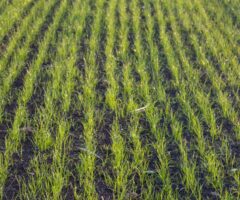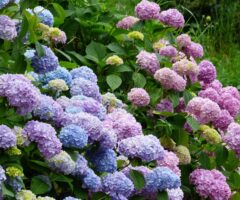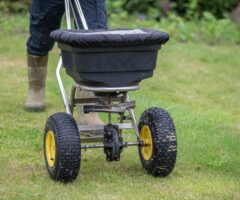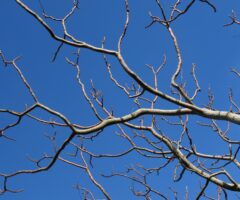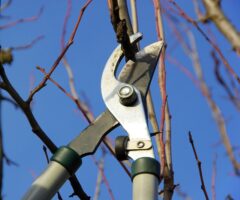A new destructive invasive pest is spreading through Michigan, and it’s only a matter of time before it reaches the Great Lakes Bay Region. The spotted lanternfly, first detected in Michigan just three years ago, has now established populations in five counties and shows no signs of slowing down. For Bay City, Essesxville, and surrounding communities, the question isn’t if this pest will arrive – it’s when, and whether your landscape will be ready.
Key Takeaways
- Spotted lanternfly is currently 100 miles from the Great Lakes Bay Region, confirmed in Wayne, Oakland, Monroe, Macomb, and Lenawee counties as of 2024.
- Common trees most at risk include red maple, black walnut, apple, river birch, and willow trees on your property.
- The pest spreads primarily through human transportation on vehicles, equipment, and plant material from infected areas.
- Proactive tree health care now can help your trees resist damage when the spotted lanternfly eventually arrives.
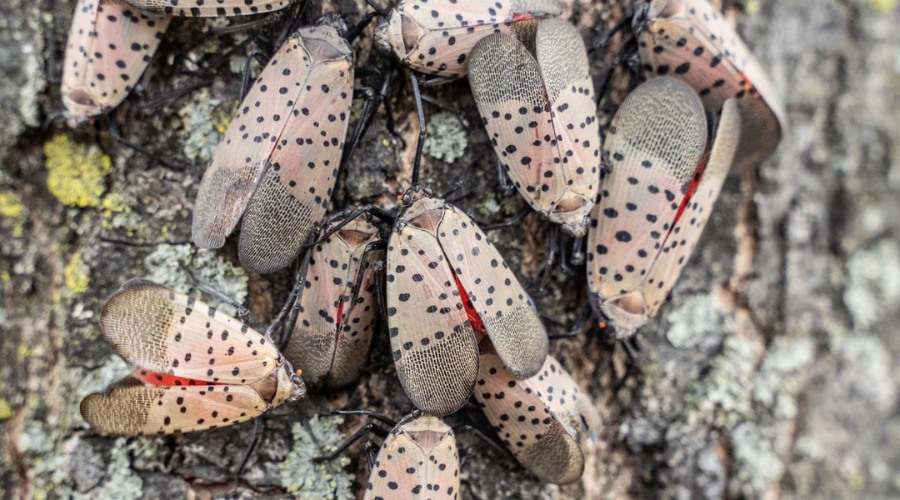
Adult spotted lanternflies are swarming on tree bark with their distinctive red underwings visible.
What is a Spotted Lanternfly?
The spotted lanternfly (Lycorma delicatula) is an invasive planthopper native to eastern Asia that has become one of the fastest-spreading invasive species in U.S. history. First detected in Pennsylvania in 2014, it has already spread to 18 states, reaching Michigan in 2022.
This colorful but devastating insect feeds on over 70 different plant species, including many trees common to our area. While spotted lanternfly can’t fly long distances on its own, it’s an expert hitchhiker that travels on vehicles, equipment, and even nursery plants from infected areas.
The spotted lanternfly damages trees by using piercing mouthparts to feed on sap from trunks and branches. The feeding itself weakens trees, but the real problem comes from what happens next. As spotted lanternflies feed, they excrete massive amounts of a sticky substance called honeydew. This honeydew:
- Attracts nuisance insects like wasps, yellow jackets, and ants
- Promotes the growth of black sooty mold that can kill plants
- Makes outdoor spaces unpleasant for recreation and gatherings
- Can affect the taste and quality of fruit from apple and other fruit trees
At high population densities, spotted lanternfly feeding can significantly reduce tree vigor and has been observed killing shoots, particularly on black walnut trees in Pennsylvania.
For property owners, this pest represents a serious threat to landscape investments. Mature trees add thousands of dollars to property values, and the cost of removing and replacing damaged trees can be substantial.
Which Trees Does the Spotted Lanternfly Infest in Michigan?
The Great Lakes Bay Region’s tree population includes many species that the spotted lanternfly readily attacks. Based on observations from Pennsylvania and other affected states, trees particularly at risk in our area include:
- Red Maple: Extremely common in landscapes and natural areas, these trees show heavy sap production that attracts spotted lanternfly during their crawler stage.
- Black Walnut: Native to Michigan, these valuable trees have shown significant damage in Pennsylvania, with feeding causing shoot dieback.
- Apple Tree: Whether ornamental crabapples in landscapes or fruit trees in yards, apples are confirmed hosts that can suffer reduced fruit quality.
- River Birch: Popular in landscaping for wet areas, these trees are among the preferred spotted lanternfly hosts.
- Willows: Common along the Saginaw Bay watershed, willows provide excellent feeding sites for all spotted lanternfly life stages.
- Tree-of-Heaven (Ailanthus altissima): The spotted lanternfly’s absolute favorite host plant.
The pest also feeds on many other species, including sumac, basswood, sycamore, and various oak species, meaning virtually no landscape is immune to potential impact.
How Close is the Spotted Lanternfly to the Great Lakes Bay Region?
Spotted lanternfly is closer to the Great Lakes Bay Region than many residents realize. Current confirmed infestations include:
- Wayne County
- Oakland County
- Monroe County
- Macomb County
- Lenawee County
The Great Lakes Bay Region sits approximately 100 miles north of these infestations, connected by major transportation corridors, including I-75, which brings regular traffic from affected areas. Unlike many invasive species that spread slowly over decades, the spotted lanternfly has demonstrated an alarming ability to rapidly expand its range – spreading to 10 states in just seven years compared to gypsy/spongy moths, which took nearly 100 years to spread from Massachusetts to New York.
How the Spotted Lanternfly Spreads
Understanding how the spotted lanternfly moves is crucial for prevention. Unlike many insects that spread naturally through flight or wind dispersal, spotted lanternfly is primarily spread by human activity.
Vehicle Transport
Adults can cling to cars, trucks, RVs, and motorcycles traveling at highway speeds. They often hide in wheel wells, under bumpers, or on grilles where they’re difficult to spot.
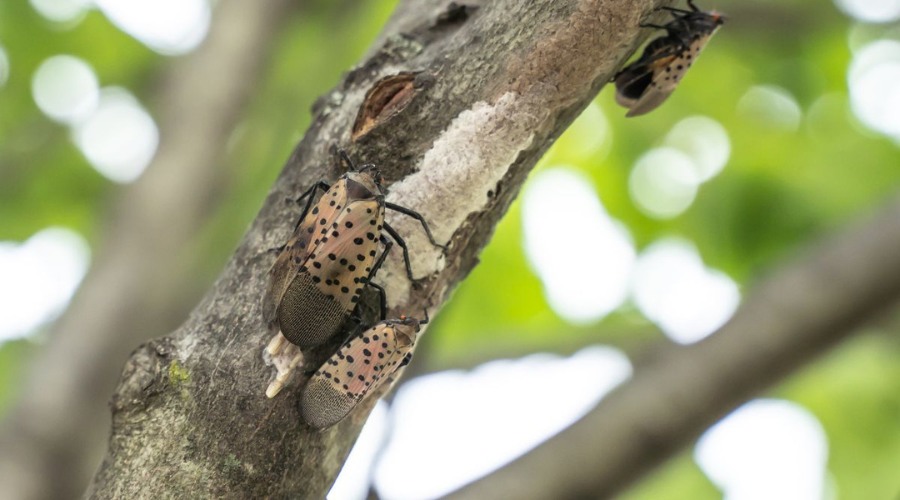
Adult spotted lanternflies gathered near their egg masses on a tree branch. The white, mud-like egg clusters can contain 30-50 eggs each and are often the first sign of an infestation.
Egg Mass Movement
From September through May, spotted lanternfly egg masses resemble dried mud or putty smeared on surfaces. These can be deposited on:
- Vehicles and trailers
- Outdoor furniture and equipment
- Building materials
- Firewood and lumber
- Recreational equipment
Plant Material
This is the most concerning pathway for the Great Lakes Bay Region, as the first Michigan detection was likely from spotted lanternfly eggs on nursery stock shipped from the east coast.
What Residents in the Great Lakes Bay Region Should Do Before the Spotted Lanternfly Arrives
While we can’t prevent spotted lanternfly from eventually reaching our area, we can take steps now to minimize the impact when it arrives.
Support Local Nurseries
One of the most effective ways to protect our community from spotted lanternfly is choosing where you purchase plants. Bay Landscaping’s 75+ years of experience and over 70 acres of plants has taught us that local sourcing is the best defense against invasive species.
Our on-site growing and supplier relationships ensure plants carry low risk of importing pests from distant regions, unlike big box stores that source from potentially infested areas across the country.
Strengthen Your Trees Before the Invasion
Healthy, vigorous trees are better able to withstand pest attacks and recover from damage. Comprehensive landscape maintenance should include:
- Professional Tree Health Assessment: Have our tree care professional evaluate your trees for existing stresses, diseases, or structural issues that could make them more vulnerable to spotted lanternfly damage.
- Soil Health Improvement: Many trees suffer from compacted soils or nutrient deficiencies. Improving soil conditions through aeration, organic amendments, and proper fertilization when needed helps trees maintain stronger defenses.
- Regular Watering: Ensure trees receive adequate water during drought periods, as water-stressed trees are more susceptible to pest damage.
Remove Preferred Host Trees
Tree-of-heaven (Ailanthus altissima) is the spotted lanternfly’s absolute favorite host plant. This invasive tree, also from Asia, is already present in parts of Michigan and provides an ideal breeding habitat for the spotted lanternfly.
If you have tree-of-heaven on your property, professional removal is strongly recommended. However, this tree is difficult to eliminate because cutting it down often stimulates aggressive root sprouting.
If you choose to remove your tree-of-heaven on your property, insist on having the stump treated with Tordon or another similar chemical for stump treatment. This will eliminate the sprouts from occurring.

Spotted lanternfly nymphs in their early stage appearing as small black insects with white spots. These wingless juveniles emerge in late spring and will molt several times before becoming red-winged adults.
Monitor and Report
Learn to identify spotted lanternfly in all its life stages:
- Egg Masses (September-May): Gray or brown patches that resemble dried mud smeared on hard surfaces, typically about 1 inch long.
- Early Nymphs (May-July): Small, wingless insects that are black with white spots and look similar to tiny beetles.
- Late Nymphs (July-September): Larger nymphs that develop red coloring with distinctive black and white markings.
- Adults (August-November): Full-grown insects about 1 inch long with gray-brown wings featuring black spots that reveal bright red underwings when opened.
If you spot any of these life stages, take photos and report immediately to the Michigan Department of Natural Resources (DNR).
Bay Landscaping Can Help Prepare Your Trees Now
The spotted lanternfly isn’t in the Great Lakes Bay Region yet, but it’s getting closer every year. And while we can’t keep it from showing up, we can help your trees stay strong and ready to handle whatever comes next.
Our team can walk your property, check the health of your trees, and give you practical tips for what to plant (and what to avoid) so you’re not caught off guard.
Let’s stay ahead of it – schedule professional landscape maintenance with Bay Landscaping by calling 989-893-0000 today.

